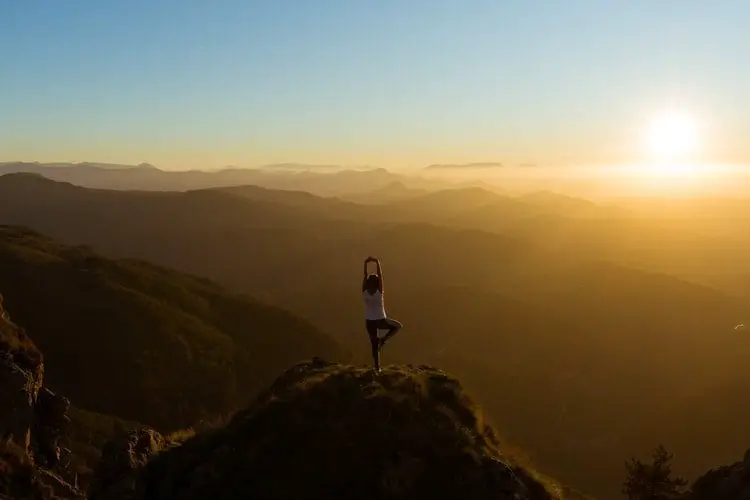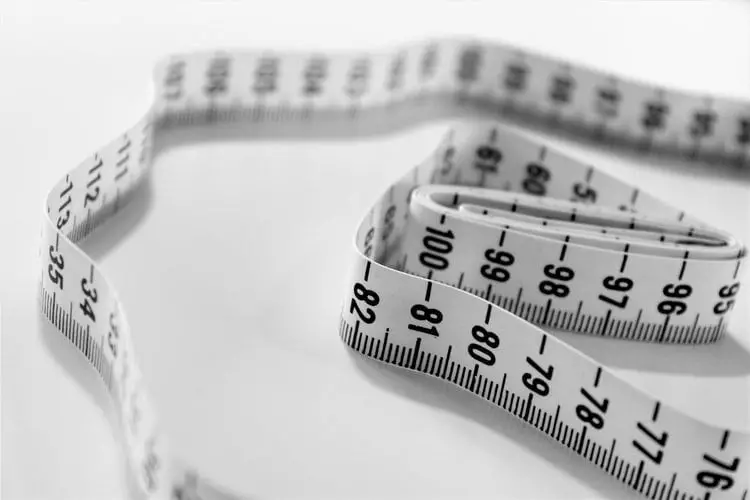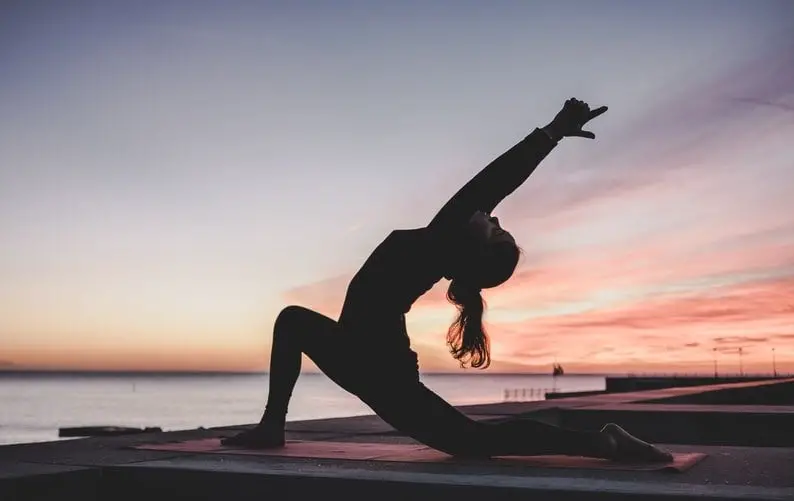HIIT, strength training, and cardio are some of the most effective ways to lose weight, but they’re also not for everyone.
If yoga sounds more appealing and slimming down is your goal, it’s natural to wonder if your daily practice can really help you shed pounds.
Don’t be fooled by yoga’s deep breathing and slow poses, many experts suggest that it can seriously trim and tone your body while working on your mind and spirit to help you get healthier.
In this article, we’ll talk about yoga for overweight beginners, so without further ado, grab your yoga mat (here is the one we recommend) and start changing your mind and body with these yoga guide!
What Is Yoga?

Yoga is a group of physical, mental, and spiritual practices or disciplines which originated in ancient India.
It is a practice that can help you build a stronger connection between your mind and body.
There are many types of yoga, some focus more on meditation and mindfulness, and others focus on strength and endurance.
But, even if you have never tried a yoga class, you may already be familiar with some yoga poses. Ever tried the plank pose? You’ve done yoga.
As part of a regular exercise regimen, yoga can help you lose weight because it burns calories.
But perhaps the key benefit of yoga is the potential to increase mindfulness, which can reduce stress and help you improve your body and overall health.
10 Yoga Benefits For Your Health
The practice of yoga for overweight beginners supports physical, mental, and spiritual development that allows you to create the best version of yourself.
And you may find that the awareness gained through a gentle, relaxing yoga practice also helps you lose weight.
That being said, here are 10 yoga benefits for your health.
Yoga Decreases Stress
When used alone or combined with other methods of alleviating stress, such as meditation, yoga can be a powerful way to keep stress at bay.
Yoga Improves Your Flexibility
Yoga poses work by stretching your muscles which can help you move better and quicker while improving your flexibility and balance.
Yoga Helps You Maintain Good Posture
Yoga can help counteract postural problems by increasing your body awareness and your core strength, all of which will go a long way towards improving your posture.
Yoga Strengthens Your Bones
It’s well-proven that weight-bearing exercises strengthens bones and helps prevent osteoporosis. When performed daily, yoga may increase bone density.
Yoga Improves Your Mood
Yoga is becoming increasingly common as a therapy to improve the quality of life for many individuals.
Yoga Promotes Quality Sleep
Studies show that incorporating yoga into your daily routine could help promote better sleep.
Yoga Increases Your Strength
By doing some specific yoga poses that we’ll talk about in just a bit, you can build and tone muscles throughout the entire body.
Yoga Eases Your Pain
Yoga can help people with arthritis, fibromyalgia, migraine, low back pain, and many other types of chronic pain conditions.
Yoga Is Good for Your Heart
Deep breathing can help lower blood pressure. Mind-calming meditation, another key part of yoga, quiets the nervous system, and eases stress.
Yoga Encourages Self Care
Yoga practice is about healing the self through self-discovery and self-acceptance. It teaches us to overcome internal and external obstacles that come with everyday life.
Can You Lose Weight With Yoga?

Yoga for weight loss sounds almost too good to be true.
From a perspective, yoga seems like the opposite of a fast-paced high-intensity interval training (HIIT) circuit or a weightlifting workout, the two kinds of exercise usually recommended for weight loss.
Yoga requires you to use your bodyweight to perform challenging poses, which can help strengthen and tone muscles.
But, if weight loss is the overall goal, then the type of yoga you’re doing is super important.
Grab your FREE yoga kick start kit here worth $197 while they’re still available, you will thank us later!
Can You Do Yoga If You Are Overweight?
The potential physical challenge of certain poses might keep you off the mat and you’re wondering how to do yoga for overweight beginners.
The yoga asanas present many of body positions to perform that further connect us with our bodies.
Depending on your strength, flexibility, and other factors, the extent of expression may vary.
Beginners who are overweight or obese can and should begin a yoga practice, just be sure to check with your doctor about the intended program first.
Although, practicing yoga doesn’t present any immediate complications, many health concerns that are linked to weight and obesity may present complications.
How Often Should You Do Yoga to Lose Weight?
You know your body best, however, as a general rule of thumb, healthy practice for yoga is usually around 3-5 times a week.
This gives you adequate time for rest, and as you may know, rest is crucial to recover, get stronger, and maintain your health.
When it comes to weight loss, try performing more active and intense forms of yoga for at least 1H.
On the other days, balance out your practice with a more relaxing, gentle class.
Yoga For Overweight Beginners – 5 Best Poses and Asanas
The following poses are for everyone, no matter your weight, shape, or ability, and all yoga for overweight beginners poses can be modified to fit your needs.
Whether you’ve got 20 pounds to lose or 200, there are plenty of poses you can do today to start reaping the physical and mental rewards of a regular yoga practice.
Mountain Pose
The word ‘Tada‘ means a mountain, that’s where the name comes from.
It is the starting position for all the other asanas, it involves the major groups of muscles and helps improve focus and concentration.
How To Do The Mountain Pose?
1. Stand with your heels slightly apart and hang your arms beside the torso.
2. Gently lift and spread your toes and the balls of your feet, then lay them softly down on the floor.
3. Balance your body weight on your feet, lift your ankles and firm your thigh muscles while rotating them inwards.
4. As you inhale, elongate your torso, and when you exhale release your shoulder blades away from your head.
Cat-Cow Pose
The difference between Cat and Cow Pose is the curve of your spine: it’s concave during Cow Pose and convex during Cat Pose.
This wonderful combination improves spine flexibility while also providing a nice stretch to your torso.
How To The Cat-Cow Pose?
1. Begin on your hands and knees with your hands and wrists directly under your shoulders, knees directly under your hips.
2. Inhaling, drop your stomach towards the mat. Slowly lift your neck and chin so you are gazing towards the ceiling, being careful not to strain your neck.
3. Exhaling, pull your belly button towards your spine and round your back toward the ceiling. Look towards the ground without bringing your chin to your chest.
Bridge pose
Bridge Pose can be whatever you need energizing, rejuvenating, or aluxuriously restorative!
How To Do The Bridge Pose?
1. Lie on the floor, and if necessary, place a thickly folded blanket under your shoulders to protect your neck.
2. Bend your knees and set your feet on the floor, heels as close to the sitting bones as possible.
3. Exhale and, pressing your inner feet and arms actively into the floor, push your tailbone upward toward the pubis, firming (but not hardening) the buttocks, and lift the buttocks off the floor.
4. Keep your thighs and inner feet parallel. Clasp the hands below your pelvis and extend through the arms to help you stay on the tops of your shoulders.
5. Lift your chin slightly away from the sternum and, firming the shoulder blades against your back, press the top of the sternum toward the chin.
6. Release with an exhalation, rolling the spine slowly down onto the floor.
Downward-Facing Dog
Deservedly one of yoga’s most widely recognized yoga poses, Adho Mukha Svanasana, offers the ultimate all-over, rejuvenating stretch.
How To Do Downward Facing Dog?
1. Come onto the floor on your hands and knees. Set your knees directly below your hips and your hands slightly forward of your shoulders. Spread your palms, index fingers parallel or slightly turned out, and turn your toes under.
2. Exhale and lift your knees away from the floor. At the first keep, the knees slightly bent and the heels lifted away from the floor. Lengthen your tailbone away from the back of your pelvis and press it lightly toward the pubis.
3. Against this resistance, lift the sitting bones toward the ceiling, and from your inner ankles draw the inner legs up into the groins.
4. With an exhalation, push your top thighs back and stretch your heels onto or down toward the floor. Straighten your knees but be sure not to lock them. Firm the outer thighs and roll the upper thighs inward slightly. Narrow the front of the pelvis.
5. Firm the outer arms and press the bases of the index fingers actively into the floor. From these two points lift along your inner arms from the wrists to the tops of the shoulders.
6. Firm your shoulder blades against your back, then widen them and draw them toward the tailbone. Keep the head between the upper arms; don’t let it hang.
Cobra Pose
Cobra Pose is one of the best exercises to promote flexibility. Below you’ll find a slightly different explanation on how to perform this yoga pose.
How To Do The Cobra Pose?
1. Lie prone on the floor. Stretch your legs back, tops of the feet on the floor.
2. Spread your hands on the floor under your shoulders. Hug the elbows back into your body.
3. On an inhalation, begin to straighten the arms to lift the chest off the floor, going only to the height at which you can maintain.
4. Firm the shoulder blades against the back, puffing the side ribs forward.
5. Lift through the top of the sternum but avoid pushing the front ribs forward, which only hardens the lower back.
6. Distribute the backbend evenly throughout the entire spine.
Final Thoughts – Is Yoga Good For Obese Beginners?
As a physical movement, practicing yoga can have a powerful impact on our bodies but it also impacts our emotional and mental health as well.
From a slower Hatha home practice to a faster-paced heated studio class, the hour or two you spend doing the physical movement, static stretching, and dynamic stretching have a powerful positive impact on your health.
The practice of yoga either through a guided class or your own practice targets and strengthens numerous muscle groups as well as increased flexibility.
This is especially true for individuals with lower baseline activity levels.
Meaning that, if you are not accustomed to thirty minutes of daily basic exercise and start upon a yoga practice a few days per week, you may begin to notice changes in your body quickly.
Want a detailed yoga plan? Click here to get the ultimate 4 week, follow-along from home yoga kick start kit for FREE!


